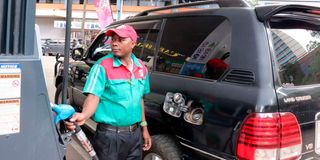More pain as fuel prices rise by Sh5.50 in Epra review

An attendant at Rubis petrol station on Koinange Street, Nairobi, on March 14, 2022.
For the next one month, a litre of super petrol in Nairobi will cost Sh150.12, diesel (Sh131) and kerosene (Sh118.94).
The prices, the authority said, are inclusive of taxes and adjusted for inflation. In Mombasa, a litre of petrol will cost 147.86 while those in Kisumu will buy the commodity at Sh150.53, same as Eldoret. In Nakuru, a litre of super petrol will cost Sh149.64.
The authority said the price revision was partly influenced by importation costs. It said the average landing cost of the imported super petrol increased by 1.46 per cent from $814 per cubic metre in March to $826.77 per cubic metre in April.
In the same period, diesel increased by 6.49 per cent from $844.57 per cubic metre to $899.36 per cubic metre while kerosene increased by 31.13 per cent from $692.95 per cubic metre to $908.66 per cubic metre. As a result, fuel prices have hiked tremendously.
Nairobi motorists
Of the Sh150.12 that Nairobi motorists will pay for fuel, the actual price is Sh176.47, meaning the government will pay Sh26.35 in subsidy. The subsidy for diesel is Sh43.94 per litre while the subsidy for kerosene is Sh50.32 per litre
“The government will utilise the petroleum development levy to cushion consumers from the otherwise high prices,” Epra said in the statement.
Further, Epra clarified that the Free on Board (FOB) of Murban crude oil lifted in April was posted at $93.99 per barrel, an increase of 10.43 per cent from the $85.11 per barrel in March.
Over the same period, Epra said, the mean monthly dollar-to-Kenya shilling exchange rate depreciated by 0.99 per cent from Sh114.60 per dollar in March to Sh115.74 in April.
Last month, the country was rocked by a wave of fuel shortages that manifested in long queues at the fuel stations, occasioned by a standoff between large oil marketers and their small rivals over supplies.
Market inquiries revealed that large oil marketers had opted to focus on their own franchise outlets. This dealt a blow to independent oil marketers who have for years depended on the large marketers for oil.





